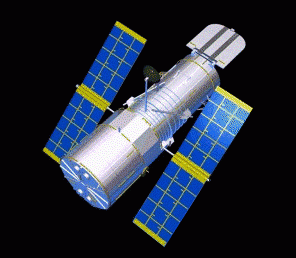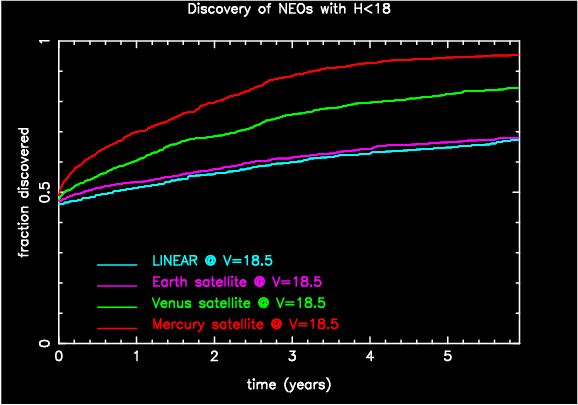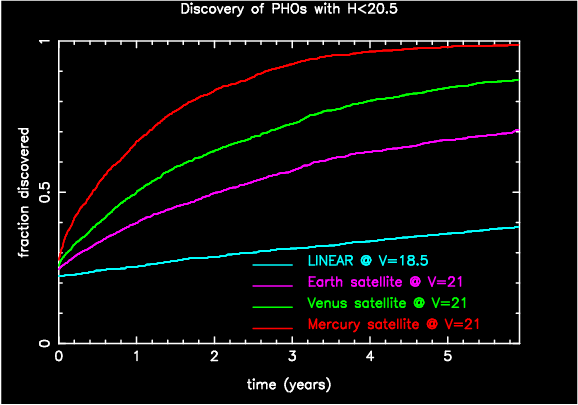
 |
Would a NEO survey conducted with a space telescope be more effective than a ground based survey? |
One advantage of a NEO survey in space would be to avoid the idle times due to poor weather and daylight. In addition, it would be possible to look for NEOs closer to the Sun than from the gound. The primary disadvantage of a space-based survey is the high cost.
Using the methods described in the previous page, we can investigate the prospects of achieving the Spaceguard goal using space based surveys. Our space-based surveys cover a band of sky of +/-20 degrees around the ecliptic every night, with the exception of a region of +/-45 degrees around the Sun.
The key parameter that determines the efficiency of
a space survey is the orbit of the satellite, with the survey becoming
much more effective as the spacecraft approaches the Sun.
 |
This figure compares the future discoveries of H<18 NEOs due to the LINEAR survey (cyan) with those that could be obtained with surveys having the same limiting magnitude, but onboard a geocentric satellite (magenta), a satellite orbiting the Sun at the distance of Venus (green) and at the distance of Mercury (red). A geocentric satellite would only increase the cost but not the effectiveness of the survey, relative to LINEAR. On the other hand, traveling to the inner solar system would be very effective, at least in term of the discovery rate. For example, the observatory residing at Mercury's distance from the Sun would easily achieve the Spaceguard goal (90% completeness) in 3 years. |
Interestingly, a survey from the inner solar system,
unlike a geocentric or ground-based survey, would preferentially
discover the most dangerous NEOs (i.e. the PHOs).
This is because the PHOs, by definition, must pass very close to the ecliptic
at 1 AU, giving them a high detection
probability near opposition, if
viewed from inside 1 AU. Hence, the goal of discovering 90% of
the PHOs with H<20.5 can be accomplished even if the survey has a moderate
limiting magnitude.
 |
This figure compares the future discoveries of H<20.5 PHOs due to the LINEAR survey with those that could be obtained with surveys having limiting magnitude V=21, onboard a geocentric satellite (magenta), a satellite orbiting the Sun at the distance of Venus (green) and at the distance of Mercury (red). A Mercury observatory with V=21 would essentially solve the problem of discovering all the NEOs that are capable of producing 1,000 MT impacts. |